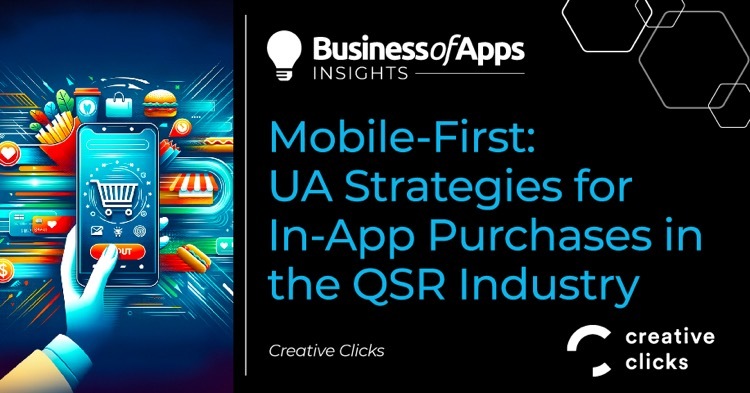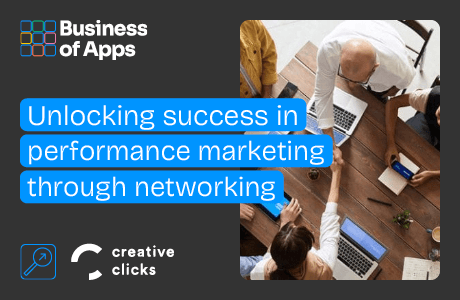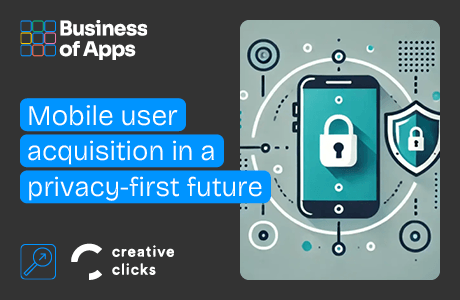Back in the day, the Quick Service Restaurant (QSR) scene was all about yelling orders across counters and jotting them down on notepads. Years later, the landscape has profoundly transformed. The ubiquity of smartphones and the subsequent rise of mobile apps have reshaped how consumers interact with QSRs. Physical menus and traditional queues are being overshadowed by the convenience of digital orders and in-app purchases. For QSR marketers, understanding and adapting to this shift is paramount – it’s the key to capturing a larger audience, driving higher revenue, and staying competitive in an increasingly mobile-centric world.
Inside this article:
- 📱 The seismic shift of the QSR industry towards a mobile-centric future.
- 🚀 How mobile features and apps are redefining the QSR customer experience.
- 🎯 Dive into the intricacies of a winning User Acquisition (UA) strategy.
- 📊 The pivotal KPIs shaping the in-app purchasing landscape.
- ⚖️ The delicate balance between scaling strategies and ensuring ROI.
- 🔄 Techniques that supercharge post-install user engagement.
- 🧭 The challenges and opportunities awaiting brands in this digital revolution.
The rise of mobile in the QSR industry
Mobile-first. That’s all we hear when it comes to modernizing service delivery in the QSR industry. The push is driven by a confluence of two main factors: changing customer habits and the increasing use of smartphones. In 2022, 6.4 billion people around the world were equipped with these devices. This number is expected to rise to 7.7 billion by 2028, showing the continuous expansion of mobile connectivity. This proliferation is in sync with the consumer’s growing inclination for on-the-go services, a trend starkly illustrated by a 2022 report highlighting that 33% of respondents desired more mobile ordering options. The correlation is clear: as mobile phone usage escalates, so does the consumer’s expectation for swift, mobile-optimized service.
Current mobile adoption rates in QSR
Some attribute the pivot towards mobile technologies to the pandemic’s necessitation for contactless interactions, while others see it as a natural evolution in response to modern consumer preferences. Regardless of the catalyst, the QSR industry’s substantial leverage of mobile technologies is there to meet the evolving tastes of a tech-savvy consumer base – one that’s increasingly inclined towards on-demand, personalized services fostered through mobile order-ahead features, in-app payments, and loyalty programs.
Here’s an observable testament to the transformative power of mobile in the QSR landscape:
Mobile order-ahead features
The convenience of ordering ahead via mobile apps to reduce wait times has been embraced both by QSRs and customers. This feature has seen a substantial surge, with notable chains like Chick-fil-A expanding their mobile order drive-thru lanes to cater to the growing consumer discretion for mobile order-ahead features.
Mobile payment options
Digital wallets and payment apps have soared in popularity, acting as triggers in transforming the conventional payment paradigm. Their ease of use, coupled with the promise of secure and instant transactions, have significantly enhanced the convenience factor for consumers, thereby reshaping the way transactions are carried out across various sectors of commerce.
A recent study by Bounteous + Olo underscores this shift within the QSR industry, revealing that 45% of customers would favor one brand’s website or app over another based solely on the availability of mobile payment options.
The growing prevalence of QSR apps
Brands are following the trajectory. The expanding mobile ecosystem is an evident playground for QSRs to engage, attract, and retain customers. A recent data snapshot reveals intriguing dynamics:
- In April 2023, the top 10 QSR apps in the U.S. saw 13.1 million downloads, marking a 22% increase from the prior month. Compared to April of the previous year, downloads of the top 36 quick-service restaurant apps have risen by 26.4%.
- The food delivery industry witnessed a significant growth spurt in 2020 and is projected to escalate to $165 billion by 2029. This is intertwined with the mobile app domain as many QSRs either align with existing food delivery platforms or cultivate in-house delivery functionalities within their digital solutions. In-app purchases strategies become paramount here, underscoring the growing indispensability of a robust mobile presence in tandem with the expanding food delivery sphere.
Crafting an effective UA strategy
Having a presence on mobile platforms is merely the initial step in today’s dynamic mobile-centric QSR environment. The true battleground is in how adeptly brands can magnetize and sustain their user base.
Master Mobile Media Buying Design Secrets! 📱🚀
Ready to skyrocket your campaign results? Grab your free guide packed with design strategies for better ad performance.
Learn MoreTo craft a formidable UA strategy, it’s crucial to meld precision with innovation, continually evolving to echo the desires and inclinations of the contemporary consumer.
The precision of targeting and segmentation
In the QSR space, a one-size-fits-all approach is outdated. Brands that master the art of nuanced targeting – leveraging deep insights – stand out distinctly. The true differentiator lies in their ability to strategically position their offerings, ensuring they resonate with the right audience at opportune moments.
Achieving this requires a multifaceted strategy that involves:
- Understanding user behavior: Before embarking on advertising campaigns, diving deep into the audience’s mobile habits, purchase triggers, and dining preferences is a cornerstone.
- Precise targeting: With the power of data analytics, brands can pinpoint consumers with timely precision, ensuring their campaigns strike when and where the chances of conversion are highest.
- Custom audience segments: Campaigns sculpted based on audience segments – from the routine diners to the vegan-conscious or the family weekenders – amplify relevance and create resonant brand experiences.
Ad formats that resonate
When navigating a landscape with multiple brands vying for consumer attention, capturing and retaining that focus becomes increasingly challenging. To cut through this noise, companies must leverage compelling ad formats that attract and engage.
Among the most effective tools are video ads. Their dynamic presentation of mouth-watering dishes can instantly ignite cravings. Interactive ads, on the other hand, offer an immersive experience, seamlessly transitioning users from mere observers to active participants.
The continuous refinement of A/B Testing
Continuous refinement is the mantra. A/B testing allows brands to test multiple ad versions, fine-tuning based on performance. Iterative optimization assures that campaigns evolve with changing consumer preferences, ensuring maximum impact and ROI in every campaign iteration.
Harnessing the power of rewards programs
Rewards, when effectively employed, can become potent instruments in UA campaigns. They create a sense of immediate value – for instance, a limited-time discount for a first-time order can spur prompt app installation and transaction initiation – an initial engagement that often serves as the gateway to deeper brand interaction. Plus, when users recognize that their actions, whether a download or a purchase, directly translate to tangible benefits, their commitment to the platform intensifies. Furthermore, by periodically introducing new rewards or enhancing existing ones based on user feedback and behavioral patterns, companies can foster a dynamic relationship with their audience that encourages both retention and organic advocacy.
Measuring and scaling success
How can QSRs consistently navigate the tumultuous seas of mobile UA while keeping the anchor of ROI firmly grounded? The answer lies in leveraging meticulous metrics, iterative optimization, and dynamic strategies.
KPIs for In-App Purchases
Quantifiable indicators are what ground decisions in the volatile domain of UA. Below is a table illustrating the key performance indicators crucial for in-app purchases:
| KPI | Description | Strategic Importance | Example Use-Case |
|---|---|---|---|
| CPA (Cost Per Acquisition) | Capital spent to acquire a new user. | Guides budgetary allocations and measures efficiency of UA campaigns. | If a campaign costs $1000 and acquires 200 users, CPA = $5. |
| ARPU (Average Revenue Per User) | Average revenue generated from each user. | Reveals value contribution of each user; identifies potential for upselling. | If 10 users generate $500 in total, ARPU = $50. |
| LTV (Lifetime Value) | Cumulative revenue generated by a user over their app engagement span. | Benchmark for determining the viability of CPA; gauges long-term user profitability. | A user interacting over 3 years generating $300 implies an LTV of $300. |
| Retention Rate | Percentage of users who continue using the app over a specific period. | Indicator of app's long-term appeal; helps in refining engagement strategies. | If 80 out of 100 users are active after 30 days, retention rate = 80%. |
| Conversion Rate (CR) | Percentage of users taking a desired action post an offer view. | Gauges the efficacy of in-app promotions or campaigns. | 50 out of 500 users make a purchase after an offer, CR = 10%. |
| Churn Rate | Percentage of users who stop using the app over a timeframe. | Identifies issues with user experience or engagement. | 20 out of 100 users stop using the app in a month, churn rate = 20%. |
| Frequency of Purchase | Average number of purchases by a user within a timeframe. | Gauges user engagement and informs loyalty program strategies. | Users make an average of 3 purchases per month. |
| AOV (Average Order Value) | Average amount spent by users in a single transaction. | Understands user spending habits for tailored promotions or combos. | Total revenue from 100 orders is $2000, AOV = $20. |
Balancing scale with ROI
After meticulously dissecting key KPIs and deciphering their delicate implications within the brand’s mobile ecosystem, scaling becomes the logical progression. However, there’s a significant risk associated with expanding too quickly. If growth isn’t based on detailed data analysis, it can lead to issues such as market oversaturation and unclear cost management, which may not align with the expected return on investment (ROI). This could manifest as budgetary overshoots without proportional revenue gains, instigating unsustainable campaign dynamics.
So, what KPI signs signal the right tempo and magnitude for scaling?
- Engagement Rate: Measures campaign resonance. High engagement? Consider scaling up.
- Retention Rate: Indicates user loyalty. High retention? Your app’s value is confirmed; expand outreach.
- Conversion Rates: Tracks efficacy from impressions to in-app actions. Positive rates? Scaling is your next step.
Key scaling strategies
- Lookalike Audiences: Leverage high-value user profiles to target analogous behaviors.
- Geo-Fencing and Location-Based marketing: Use geo-fencing to trigger immediate actions when users enter a specific vicinity. At the same time, employ broader location-based marketing strategies to tailor promotions and offers to regional preferences and habits.
- Dynamic Creative Optimization: Adjust ads on the fly based on live engagement metrics, ensuring adaptive campaign efficacy.
Integrating UA with Post-Install engagement
Retargeting. Push notifications. In-app messages. Three tactics central to fortifying the post-acquisition user journey.
Retargeting harnesses algorithms to identify user drop-off patterns, re-engaging them with dynamic ads informed by granular in-app behavior data. Push notifications utilize adaptive scheduling, capitalizing on peak user activity windows to maximize open rates and engagement. Conversely, in-app messages, driven by behavioral triggers and segmentation, deliver contextualized content, elevating user interaction and optimizing conversion funnels.
The bottom line
The industry is undergoing a transformative shift, adapting rapidly to the mobile-first QSR marketing landscape. From nuanced targeting to adaptive user acquisition, brands are pushing boundaries to meet ever-evolving consumer demands in this digital epoch. As mobile app functionalities and in-app purchases gain increasing traction, companies stand at a pivotal crossroad, determining how best to harness this momentum for sustained growth and relevance.
However, charting the right course in such a dynamic environment isn’t straightforward – at least not without the proper guidance. Connect with our seasoned experts. They thrive in transforming challenges into strategic opportunities, guaranteeing your brand capitalizes on the QSR industry’s digital revolution.













